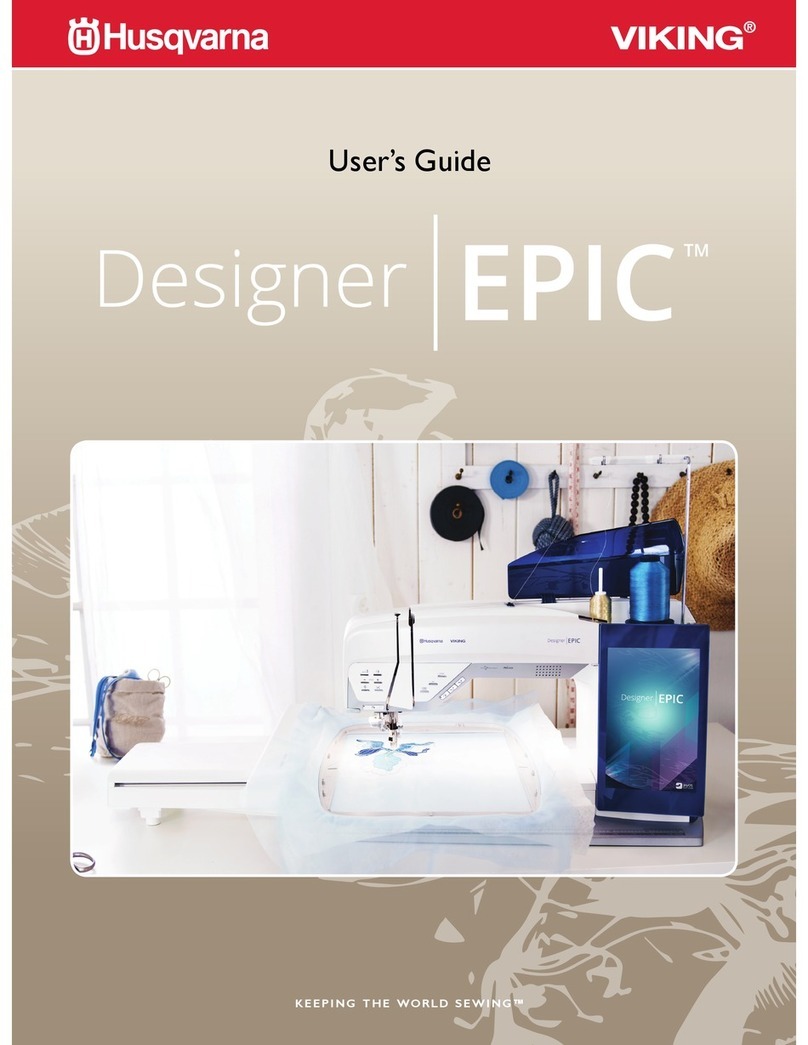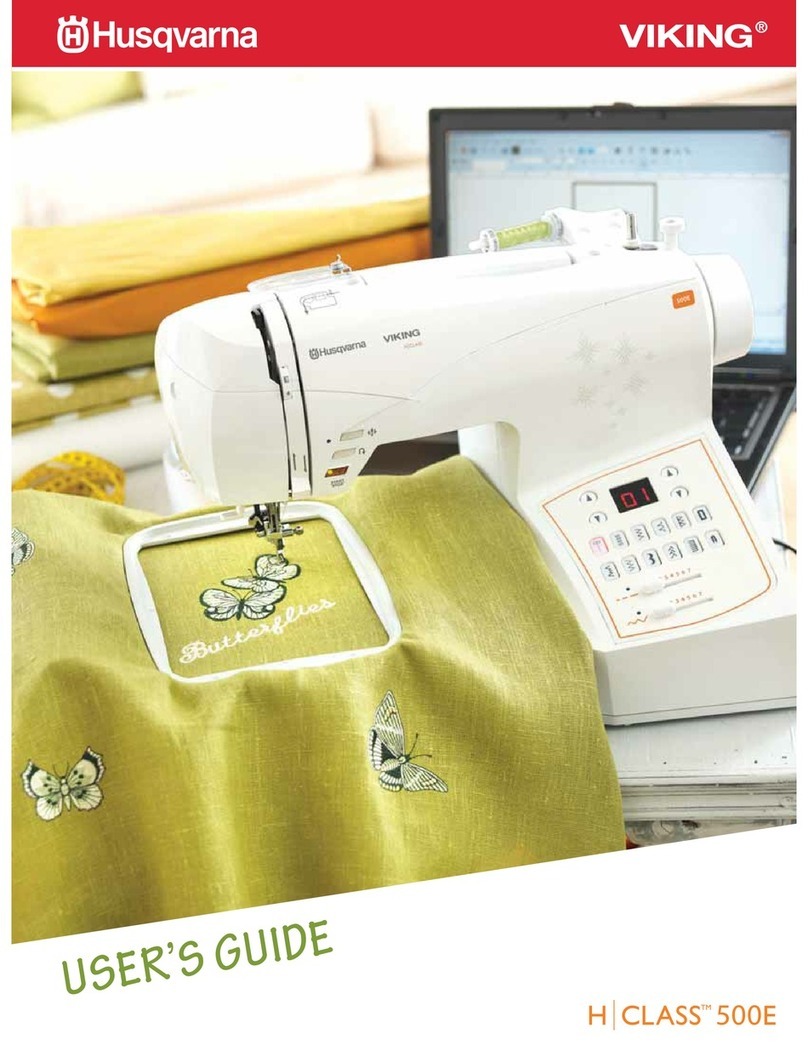Viking Designer Ruby User manual

User’s Guide
KEEPING THE WORLD SEWING™

This household sewing machine is designed to comply with IEC/EN 60335-2-28 and UL1594
IMPORTANT SAFETY INSTRUCTIONS
When using an electrical appliance, basic safety precautions should always be followed, including the following:
Read all instructions before using this household sewing machine.
DANGER –To reduce the risk of electric shock:
• A sewing machine should never be left unattended when plugged in. Always unplug this sewing machine from the
electric outlet immediately after using and before cleaning.
WARNING –To reduce the risk of burns,Àre,
electric shock,or injury to person:
• This sewing machine is not intended for use by persons (including children) with reduced physical, sensory or mental
capabilities, or lack of experience and knowledge, unless they have been given supervision or instruction concerning use
of the sewing machine by a person responsible for their safety.
• Children should be supervised to ensure that they do not play with the sewing machine.
• Use this sewing machine only for its intended use as described in this manual. Use only attachments recommended by
the manufacturer as contained in this manual.
• Never operate this sewing machine if it has a damaged cord or plug, if it is not working properly, if it has been dropped
or damaged, or dropped into water. Return the sewing machine to the nearest authorized dealer or service center for
examination, repair, electrical or mechanical adjustment.
• Never operate the sewing machine with any air openings blocked. Keep ventilation openings of the sewing machine and
foot controller free from the accumulation of lint, dust, and loose cloth.
• Keep Àngers away from all moving parts. Special care is required around the sewing machine needle.
• Always use the proper needle plate. The wrong plate can cause the needle to break.
• Do not use bent needles.
• Do not pull or push fabric while stitching. It may deÁect the needle causing it to break.
• Wear safety glasses.
• Switch the sewing machine off (“0”) when making any adjustment in the needle area, such as threading needle, changing
needle, threading bobbin, or changing presser foot, etc.
• Always unplug sewing machine from the electrical outlet when removing covers, lubricating, or when making any other
user servicing adjustments mentioned in the instruction manual.
• Never drop or insert any object into any opening.
• Do not use outdoors.
• Do not operate where aerosol (spray) products are being used or where oxygen is being administrated.
• To disconnect, turn all controls to the off (“0”) position, then remove plug from outlet.
• Do not unplug by pulling on cord. To unplug, grasp the plug, not the cord.
• Hold plug when rewinding into cord reel. Do not allow plug to whip when rewinding.
• This sewing machine is provided with double insulation. Use only identical replacement parts.See instructions for
Servicing of Double-Insulated Appliances.
SAVETHESE INSTRUCTIONS
SERVICING OF
DOUBLE INSULATED PRODUCTS
In a double-insulated product, two systems of insulation are provided instead of grounding. No ground means is provided
on a double-insulated product, nor should a means for grounding be added to the product. Servicing of a double-insulated
product requires extreme care and knowledge of the system, and should be done only by qualiÀed service personnel.
Replacement parts for a double-insulated product must be identical to those parts in the product. A double-insulated
product is marked with the words ‘DOUBLE INSULATION’ or ‘DOUBLE INSULATED’.

TABLE OF CONTENTS
1 Getting to know your machine 1:5
MACHINE OVERVIEW 1:6
Rear Side...........................................................................1:6
Needle Area......................................................................1:6
Accessory Tray.................................................................1:7
Parts of the Embroidery Unit.......................................1:7
ACCESSORIES 1:7
Included Accessories......................................................1:7
Hoops Included...............................................................1:7
Accessories Included - Not in the Picture..................1:8
Presser Feet......................................................................1:8
STITCHES 1:10
2 Set Up 2:1
UNPACKING 2:2
Connect the Power Cord and Foot Control...............2:2
Pack Away after Sewing .................................................2:2
FREEARM 2:3
SPOOL PINS 2:3
Horizontal Position.........................................................2:3
Vertical Position...............................................................2:3
Auxiliary Spool Pin.........................................................2:3
THREADINGTHE UPPERTHREAD 2:4
Needle Threader..............................................................2:4
Threading for Twin Needle...........................................2:5
THREAD CUTTER 2:5
THREAD SENSOR 2:5
BOBBINWINDING 2:6
Bobbin Winding Through the Needle.........................2:6
Bobbin Winding while Embroidering or Sewing.......2:7
INSERTINGTHE BOBBIN 2:7
CHANGINGTHE PRESSER FOOT 2:7
CHANGINGTHE NEEDLE 2:8
NEEDLES 2:8
THREADS 2:9
STABILIZERS 2:9
PICTOGRAM™PEN 2:9
USB PORTS 2:10
USB embroidery stick...................................................2:10
Connect to and Remove from the USB Port............2:10
CONNECTINGTHE MACHINETOYOUR COMPUTER 2:11
5D™ Embroidery Software........................................2:11
Installing your Software...............................................2:11
Install Hardware Drivers and
Connect the Embroidery Machine...........................2:11
How to Launch the Programs.....................................2:12
Embroidery Machine Communication module........2:12
How to Update your Machine.....................................2:12
3 Settings & Functions 3:1
INTERACTIVE COLORTOUCH SCREEN 3:2
COMMON ICONS/FUNCTIONS 3:2
OK.....................................................................................3:2
Cancel................................................................................3:2
Touch & Hold..................................................................3:2
TOOLBAR 3:2
START MENU 3:2
SEWING/EMBROIDERY MODE 3:2
QUICK HELP 3:3
EXTENDEDTOOLBAR 3:3
STITCH MENU 3:3
How to Select a Stitch....................................................3:3
FONT MENU 3:3
Selecting a Font...............................................................3:3
DESIGN MENU 3:4
Selecting a Design...........................................................3:4
EMBROIDERYADVISOR™ 3:4
FILE MANAGER 3:4
SET MENU 3:5
Stitch Settings .................................................................3:5
Sewing Settings................................................................3:6
Machine Settings..............................................................3:8
Sound Settings.................................................................3:9
Screen Settings.................................................................3:9
INFORMATION MENU 3:10
FUNCTION BUTTONS 3:11
Speed + and -.................................................................3:11
STOP (Monochrome)..................................................3:11
FIX (Baste).....................................................................3:11
Reverse............................................................................3:11
Selective Thread Cutter................................................3:12
Needle Stop Up/Down (Trim Position) ...................3:12
Start/Stop.......................................................................3:12
EXCLUSIVE SENSOR SYSTEM™ 3:12
Sensor Foot Up and Extra Lift...................................3:12
Sensor Foot Down and Pivot......................................3:12
4 Sewing 4:1
SEWING MODE - OVERVIEW OF ICONS 4:2
EXCLUSIVE SEWINGADVISOR™ 4:3
Fabric Selection...............................................................4:3
Sewing Techniques..........................................................4:4
Extended SEWING ADVISOR™..............................4:4
SELECTA STITCH 4:4
STITCH SETTINGS 4:5
Stitch Settings in SET Menu..........................................4:6
FREE-MOTIONTECHNIQUE 4:7
RAISEAND LOWERTHE PRESSER FOOT 4:7
SEWINGTECHNIQUES 4:8
Seam..................................................................................4:8
Overcast............................................................................4:9
Seam and Overcast........................................................4:10
Seam/Overcast for Ribbing........................................4:10
Baste ...............................................................................4:11
Blind Hem......................................................................4:11
Hem.................................................................................4:12
Perfectly Balanced Sensor One-Step Buttonhole.....4:13
Manual Buttonhole.......................................................4:14
Embroidered buttonhole.............................................4:14
Programmable Button Sew On...................................4:14
Bartacks...........................................................................4:15
Manual Bartack..............................................................4:15
4-way Stitches - Menu S...............................................4:16
8-Way Stitches – Menu T.............................................4:17
Special Sewing Techniques..........................................4:18
Taper Satin Stitch..........................................................4:18
Decorative Tapering Stitches.......................................4:18
SEWING POP-UP MESSAGES 4:19

5 Program 5:1
IMPORTANT PROGRAM MODE INFORMATION 5:2
PROGRAM - OVERVIEW OF ICONS 5:2
TO PROGRAM IN SEWING MODE 5:3
TO PROGRAM IN EMBROIDERY EDIT 5:3
EDITYOUR STITCH OR LETTERING PROGRAM 5:3
Preview..............................................................................5:4
Adjust the Entire Program............................................5:4
Stitch program commands.............................................5:4
SEWINGA STITCH PROGRAM 5:4
TO SAVEA STITCH PROGRAM 5:5
Save to “My Stitches”.....................................................5:5
Save your Program in “My Files”.................................5:5
TO RE-LOADA STITCH PROGRAM 5:6
PROGRAM POP-UP MESSAGES 5:6
6 Embroidery Set Up 6:1
EMBROIDERY UNIT OVERVIEW 6:2
EMBROIDERY HOOP OVERVIEW 6:2
CONNECTTHE EMBROIDERY UNIT 6:2
REMOVETHE EMBROIDERY UNIT 6:3
TO HOOPTHE FABRIC 6:3
SLIDE ONTHE HOOP 6:4
BUILT-IN DESIGNS 6:4
DESIGNER RUBY™ Sampler Book.........................6:4
GETTING STARTED EMBROIDERING 6:5
7 Embroidery Edit 7:1
MAIN FUNCTIONS INTHE
EXTENDED EMBROIDERY EDITTOOLBAR 7:2
Load a Stitch....................................................................7:2
Load a Font......................................................................7:2
Load a Design..................................................................7:2
Exclusive EMBROIDERY ADVISOR™...................7:2
File Manager.....................................................................7:2
SET Menu........................................................................7:2
Information Menu..........................................................7:2
EMBROIDERY EDIT - OVERVIEW OF ICONS 7:3
MY HOOPS 7:3
RESIZE 7:4
Important Resize information.......................................7:5
COLOR EDIT 7:6
Thread Color Change.....................................................7:6
Grid...................................................................................7:6
2-dimensional/3-dimensional view toggle..................7:6
EDIT STITCH PROGRAM 7:7
SAVE EDITED DESIGN 7:7
PARK POSITION 7:7
MOVETO HOOP 7:7
ZOOM 7:7
STITCH-OUT ORDER OF SELECTED DESIGN 7:7
TOUCH FUNCTIONS 7:8
UNDO 7:9
REDO 7:9
MIRROR SIDE-TO-SIDEAND END-TO-END 7:9
DELETE 7:9
DUPLICATE 7:9
HOWTO SELECT DESIGNS 7:10
Advanced selection.......................................................7:10
PROGRAM EMBROIDERY FONTS 7:11
EMBROIDERY EDIT POP-UP MESSAGES 7:12
8 Embroidery Stitch-Out 8:1
TO ENTER EMBROIDERY STITCH-OUT 8:2
EMBROIDERY STITCH-OUT - OVERVIEW OF ICONS 8:2
DESIGN POSITIONING 8:3
How to use Design Positioning....................................8:4
BASTE IN HOOP 8:6
MOVE HOOP 8:6
FULL SCREEN 8:7
MONOCHROME 8:7
CORNER CHECK 8:7
ZOOM 8:7
REMAINING EMBROIDERYTIME BY COLOR 8:7
THREADTENSION CONTROL 8:8
STEP STITCH-BY-STITCH CONTROL 8:8
Go to Stitch......................................................................8:8
RETURNTO EMBROIDERY EDIT 8:8
NUMBER OF STITCHES IN
EMBROIDERY COMBINATION 8:9
NUMBER OF STITCHES IN
CURRENT COLOR BLOCK 8:9
COLOR BLOCK LIST 8:9
FUNCTION BUTTONS IN EMBROIDERY STITCH-OUT 8:10
EMBROIDERY STITCH-OUT POP-UP MESSAGES 8:11
Design Positioning........................................................8:12
9 File Manager 9:1
FILE MANAGER - OVERVIEW OF ICONS 9:2
AVAILABLE MEMORY 9:2
FILE FORMATS 9:2
BROWSE FILE MANAGER 9:3
List View...........................................................................9:3
My Designs.......................................................................9:3
My Fonts ..........................................................................9:3
My Files.............................................................................9:3
Built-in designs................................................................9:3
External Device...............................................................9:4
Open a Folder..................................................................9:4
Open a File.......................................................................9:4
Move Up One Folder Level...........................................9:4
Folder Structure...............................................................9:4
ORGANIZE 9:5
Create a New Folder.......................................................9:5
Rename a File or Folder.................................................9:5
Move a File or Folder.....................................................9:5
Copy a File or Folder......................................................9:5
Delete a File or Folder ...................................................9:5
FILE MANAGER POP-UP MESSAGES 9:6
10 Maintenance 10:1
CLEANINGTHE MACHINE 10:2
TROUBLESHOOTING 10:3
INDEX 10:5
INTELLECTUAL PROPERTY 10:11

1GETTINGTO KNOWYOUR MACHINE

1:6
16
20
24
22
21
23
1
2
5
12
7
3
4
8
10
9
13
6
11
8
17
18
19
14
15
27
26
25
34
33
31
29 32
28 30
1. Lid
2. Pre-Tension Thread guide
3. Thread tension discs
4. Thread take-up lever
5. Thread slots
6. Thread tension disc for bobbin winding
7. Thread cutter
8. LED-lights
9. Needle plate
10. Bobbin cover
11. Button ruler and built-in tape measure
12. Base plate
13. Function button panel
14. Main spool pin
15. Bobbin winding thread guide
16. Auxiliary spool pin
17. Bobbin winder
18. Thread cutter for bobbin winding
19. Bobbin winder lever
20. Handwheel
21. Interactive Color Touch Screen
22. Built-In USB ports
23. Stylus holder
24. ON/OFF switch, connectors for power
cord and foot control
REAR SIDE
25. Handle
26. Free arm
27. Embroidery unit connection socket
NEEDLEAREA
28. Sensor One-Step Buttonhole Foot
socket
29. Built-In needle threader
30. Needle bar
31. Needle clamp
32. Needle thread guide
33. Presser foot bar and presser foot ankle
34. Presser foot
MACHINE OVERVIEW

GETTING TO KNOW YOUR MACHINE 1:7
37
38
39 40
41
40
46 47 48 49
43 44 45
50 51 52
53 54 55 56
42
57 58
36
35
ACCESSORYTRAY
The accessory tray features special compartments for
presser feet and bobbins, plus space for needles and other
accessories. Store the accessories in the tray so that they are
easily accessible.
35. Space for accessories
36. Removable presser feet and bobbin holder
PARTS OFTHE EMBROIDERY UNIT
(type BE 18)
37. Embroidery unit release button (underside)
38. Embroidery arm
39. Embroidery hoop attachment
40. Level adjustment feet
41. Embroidery unit socket
ACCESSORIES
INCLUDEDACCESSORIES
42. Stylus
43. Thread net
44. Edge/Quilting guide
45. Felt pad (2)
46. USB embroidery stick (1 GB)
47. Screwdriver
48. Seam ripper
49. Brush
50. 2 spool caps, large
(1 attached on the machine at delivery)
51. Spool cap, medium
(attached on the machine at delivery)
52. Spool cap, small
53. Multipurpose tool/Button reed
54. Hoop clips (16)
55. 11 Bobbins (1 in machine at delivery)
56 PICTOGRAM™ Pen
HOOPS INCLUDED
57. DESIGNER™ Royal Hoop (360x200)
58. DESIGNER™ Splendid Square Hoop (120x120)

1:8
PRESSER FEET
7Utility FootA
Snapped onto the machine upon delivery. This foot is used mainly for straight stitching and
zigzag stitching with a stitch length longer than 1.0.
7Decorative Stitch Foot B
For sewing close zigzag stitches (satin stitches) with less than 1.0 mm stitch length, other utility
stitches or decorative stitches, use this foot. The tunnel on the underside of the foot is designed
to feed smoothly over the stitches.
7Buttonhole Foot C
For manual buttonholes. This foot has guide lines to determine buttonhole length. The middle
measures a 5/8'' (15 mm) from the fabric edge. The two tunnels on the underside of the foot
ensure a smooth feed over the buttonhole columns. The Ànger on the back of the foot holds
cording for corded buttonholes.
Blindhem Foot D
This foot is used for blindhem stitches. The inner edge of this foot guides the fabric. The right
toe of the foot is designed to ride along the hem edge.
7Zipper Foot E
This foot can be snapped on either to the right or to the left of the needle. This makes it easy to
sew both sides of the zipper. Move needle position to right or left to sew closer to zipper teeth
or for covering large cording.
7Non-Stick Glide Foot H
This foot, with a non-stick coating underneath, is used when sewing foam, vinyl, plastic, or
leather to keep these materials from sticking to the foot.
ACCESSORIES INCLUDED - Not in the Picture
• 5D™ Embroidery Machine Communication CD
• Carrying Case (attached on the machine upon delivery)
• Scissors
• Foot control
• Power cord
• USB PC cable
• Needles
• Embroidery thread
• Pieces of fabric and stabilizer
• DESIGNER RUBY™ Sampler book
• User’s Guide
• Warranty card

GETTING TO KNOW YOUR MACHINE 1:9
Edging Foot J
This foot is used for overcasting and seam/overcasting, with stitches that have a stitch width
of 5.0 and 5.5 mm. Stitches form over the pin which prevents puckering at the edge of the
fabric.
Quilter’s 1/4” Piecing foot P
This foot is used when piecing quilt blocks. The foot has distance guidelines marks 1/4"
(6 mm) and 1/8" (3 mm) from the needle.
Embroidery/Darning Foot R
This foot is used for free motion embroidery/quilting/stitching and hoop embroidery.
7Side Motion Foot S
This foot is used for side-motion/Omnimotion stitches.
7Decorative Stitch Foot BTransparent
A clear foot for decorative sewing makes it easy to match stitches. Same tunnel on the
underside as Presser Foot B.
7
Sensor One-Step Buttonhole Foot
Plug into the machine then enter the desired buttonhole length to sew Sensor One-Step
Buttonholes. The middle mark measures a 5/8" (15 mm) from fabric edge.
Self-Adhesive Glide Plates
Used for Presser Foot C/Sensor One-Step Buttonhole Foot when sewing buttonholes on
plastic-coated fabrics, leather, etc.

1:10
STITCHES
A – Utility Stitches
Stitches for garment sewing and mending.
Stitch Stitch description Presser
Foot
A1,A2,A3 – Straight Stitch,left,center and right needle position
For all types of sewing. Touch stitch width and Side-to-Side mirror image to select 29 different needle
positions.
A
A4,A5,A6 – Stretch Stitch,left,center and right needle position
For seams in tricot and stretch fabrics. A
A7,A8,A9 – Reinforced Straight Stitch,left,center and right needle position
Triple and elastic, for reinforced seams. For topstitch, increase the stitch length. 29 different needle
positions.
A
A10,A11,A12 – Zigzag,left,center and right needle position
For sewing on lace, bands and appliqués. A
A13 –Three Step Zigzag
For overcasting, mending, sewing on patches and elastic. Suitable for light and medium weight fabrics. A
A14 – Serpentine Stitch
For mending and elastic applications. A
A15 – Four-Step Zigzag
For overcasting, mending, sewing on patches and elastics on loosely woven fabrics. A
A16 – Overcast Stitch
Seam and overcast in one step along the edge or trim later. For light stretch and non-stretch fabrics. J
A17 – Stretch Seam Overcast Stitch
Seam and overcast in one step along the edge or trim later. For medium and medium/heavy stretch
fabrics.
B
A18 – Double Overlock Stitch
Seam and overcast in one step along the edge or trim later. For heavy stretch and heavy woven fabrics. B
A19 – Overlock Stitch
Seam and overcast in one step along the edge or trim later. For medium stretch fabrics. B
A20 – Flatlock Stitch
Decorative hems and overlapped seams, belts and bands. For medium/heavy stretch fabrics. B
A21 – Elastic/Casing Stitch
For overlapped seams in tricot. To sew casing over narrow elastic. B
A22 – Reinforced Zigzag Stitch
For joining fabric edge to edge or overlapping in leather. For decorative sewing. B
A23 – Basting Stitch
For joining two pieces of fabric with a long stitch length and reduced tension. A
A24 – Stretch Blind Hem Stitch
Blind hems in stretch medium and heavy fabrics. D

GETTING TO KNOW YOUR MACHINE 1:11
Stitch Stitch description Presser
Foot
A25 –Woven Blind Hem Stitch
Blind hems in medium and heavy woven fabrics. D
A26 – Shell Edge Stitch
For edgings, sew over the edge on light stretch fabrics, sew woven fabric on bias. A
A27 – Elastic or Smocking Stitch
Sew over two rows of elastic thread for elastic shirring. B
A28 – Bridging Stitch
For joining two pieces of fabric with Ànished edges and for elastic shirring. B
A29 – Bartack Stitch
Reinforce pockets, shirts openings, belt loops as well as at lower end of a zipper. B
A30 – Darning Stitch (Forward and Backward)
Darn and mend small holes in work clothes, jeans, tablecloths and linen towels. Stitch over hole, touch
reverse for continuous darning and auto stop.
A
A31 – Darning Stitch (Side to Side)
For mending small tears. A
A32 – Reinforced Darning Stitch
Darn and mend work clothes, jeans, table cloths and linen towels. Stitch over hole, touch reverse for
continuous darning and auto stop.
A
A33 – Bartack,Manual
Reinforce pockets, shirts openings, belt loops as well as at lower end of a zipper. B
A34 – Gathering Stitch
For gathering. A
A35 – Belt Loop Stitch
For securing belt loops. A
A36 –Three-Step Zigzag
For overcasting, mending, sewing on patches and elastic. Suitable for light and medium weight fabrics. J
A37 –Two-Step Zigzag
For joining two pieces of fabric with Ànished edges and for elastic shirring. A
A38 – Straight stitch with FIX
Begins and ends with forward and reverse sewing. A
A39 – Straight Basting Stitch
Use together with the foot control to baste pieces of the fabric together. Feed the fabric by moving to
the next baste position when sensor foot lifts. Feed teeth lowered automatically.
A
A40 – Zigzag Basting
Use together with the foot control to baste layers of the fabric by moving to the next baste position
when foot lifts.
A

1:12
Stitch Stitch description Presser Foot
B1 – Bartack Buttonhole
For most fabric weights. Sensor Buttonh.
Foot /C
B2 – Round-End Buttonhole
For blouses and children’s garments. Sensor Buttonh.
Foot /C
B3 – Medium Reinforced Buttonhole
For medium fabrics. C
B4 – Heirloom Buttonhole
For hand look on Àne and delicate fabrics.
Tip: For jeans buttonholes, increase length and width of the buttonhole. Use thicker thread.
Sensor Buttonh.
Foot /C
B5 – Rounded Heirloom Buttonhole
For hand look on Àne and delicate fabrics. Sensor Buttonh.
Foot /C
B6 – Keyhole Buttonhole
Square end for tailored jackets, coats, etc. Sensor Buttonh.
Foot /C
B7 – Heavy Duty Buttonhole
With reinforced bartacks. Sensor Buttonh.
Foot /C
B8 – Leather Buttonhole (Straight Stitch)
For leather and suede. A
B9 – Bound Buttonhole (Straight Stitch)
With extra cutting space for bound buttonholes. A
B10 –Automatic Button Sewing
For sewing on buttons -
B11 – Round Eyelet
For belts, laces, etc. B
B12 – Decorative Fashion Buttonhole
For most fabric weights. Sensor Buttonh.
Foot /C
B - Buttonhole Stitches
Different styles of buttonholes, eyelets and button sewing.

GETTING TO KNOW YOUR MACHINE 1:13
C - Pictogram Stitches
Pictogram satin elements to program
original satin stitch designs.
D - Heirloom Stitches
For hemstitching, smocking and sewing
on lace and trims.
E - Quilt Stitches
Stitches for all types of quilting
techniques.
F -Appliqué Stitches
For sewing appliqués with different
effects.

1:14
G - Children Stitches
Stitches suitable for sewing on
children’s clothes and projects.
H - Scallop Stitches
Create scallop details and Ànish edges
with beautiful scallop stitches.
J -Vintage Stitches
A selection of quilt stitches for crazy
patch quilting and decorative stitching.

GETTING TO KNOW YOUR MACHINE 1:15
K - Omnimotion Stitches
Program these stitches into an unlimited number of
combinations. Stitches are formed with side motion. The stitch
width can be up to 40 mm wide or more.
L - Decorative Stitches
For decorative sewing.
M - Crafting Stitches
For decorative stitches to embellish
crafts.
N - Fashion Stitches
Fashion stitches to decorate clothing
and accessories.

1:16
S - 4-way Stitches
For directional sewing and patching
using the free arm
T - 8-way Stitches
Straight stitch and reinforced straight
stitch in eight different directions
without turning the fabric.
U - My Stitches
Save your own personally adjusted and
favorite stitches and stitch programs.
X - Specialty Stitches
Sew special techniques including candlewicking and edging. Extra accessories
may be needed. Use Quick Help for detailed information

GETTING TO KNOW YOUR MACHINE 1:17
BlockAlphabet Outline blockAlphabet Brush LineAlphabet
Z - DecorativeTapering Stitches
Decorative stitches with tapering.

1:18
ScriptAlphabet CyrillicAlphabet HiraganaAlphabet

SET UP
2

2:2
OFF
ON
312
UNPACKING
1. Place the box on a steady, Áat surface. Lift off the
machine carrying case. Lift your machine out of the
box and remove the outer packaging.
2. Remove all other packing material and the plastic bag.
CONNECTTHE POWER CORDAND FOOT
CONTROL
Among the accessories you will Ànd the power cord and
the foot control.
Note: Before plugging in the foot control, check to ensure that it is type
“FR5” (see underside of foot control).
1. Pull out the cord from the foot control. Connect the
foot control cord to the front socket on the bottom
right side of the machine (1).
2. Connect the power cord to the rear socket on the
bottom right side of the machine (2).
3. Press the ON/OFF switch to ON to turn on power
and light (3).
For the USA and Canada
This sewing machine has a polarized plug (one blade wider
than the other). To reduce the risk of electric shock, this
plug is intended to Àt in a polarized outlet only one way. If
the plug does not Àt fully in the outlet, reverse the plug. If
it still does not Àt, contact a qualiÀed electrician to install
the proper outlet. Do not modify the plug in any way.
PACKAWAYAFTER SEWING
1. Press the ON/OFF (3) switch to OFF.
2. Unplug the cord from the wall socket and then from
the machine (2).
3. Unplug the foot control cord from the machine (1).
Pull the cord gently and release. The cord will retract
itself into the foot control.
4. Place all accessories in the accessory tray. Slide the tray
on to the machine, behind the free arm.
5. Place the foot control in the space above the free arm.
6. Place the hard cover over your machine.
Table of contents
Other Viking Sewing Machine manuals
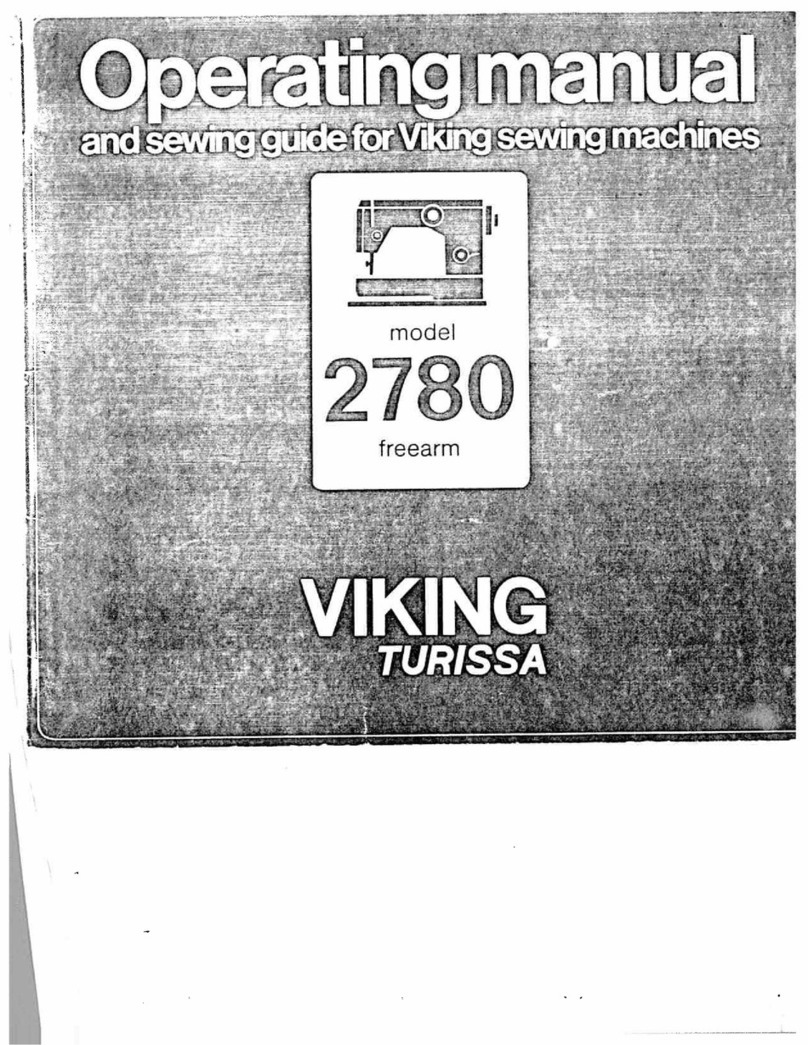
Viking
Viking 2780 User manual

Viking
Viking Designer Topaz User manual

Viking
Viking Huskystar 215 User manual

Viking
Viking Turissa Instruction and safety manual
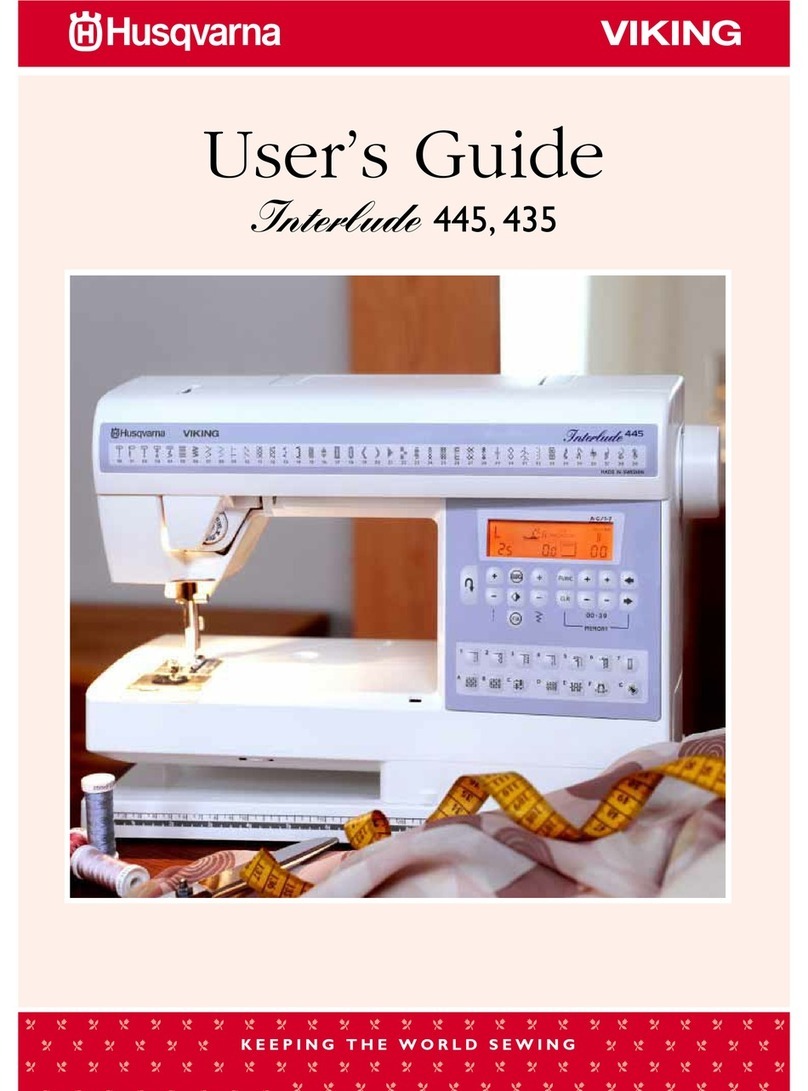
Viking
Viking Interlude 445 User manual
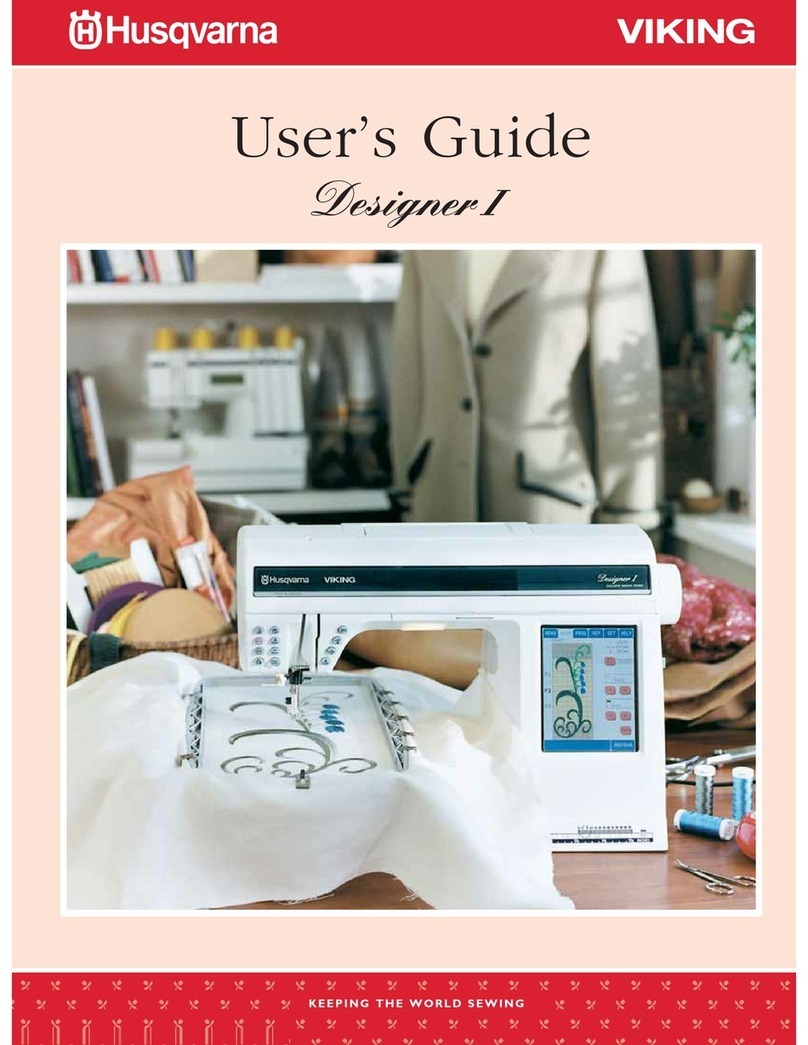
Viking
Viking Designer I User manual
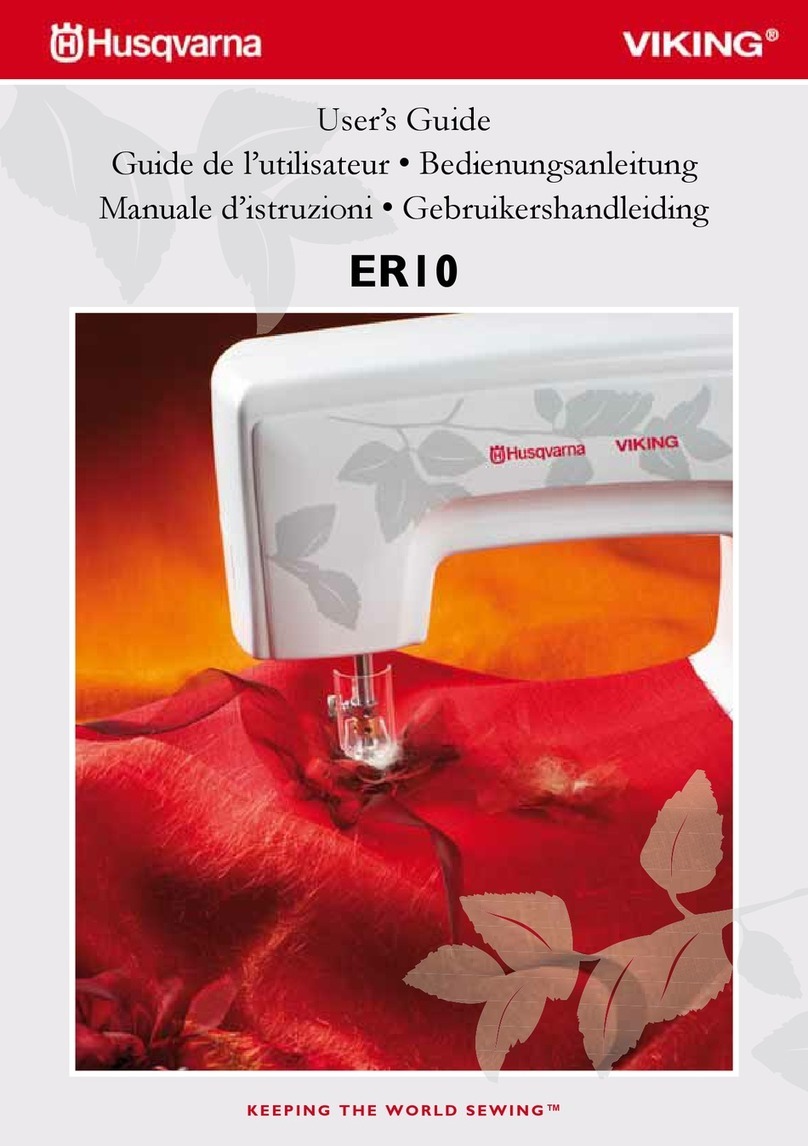
Viking
Viking ER10 User manual

Viking
Viking Huskystar 207 User manual
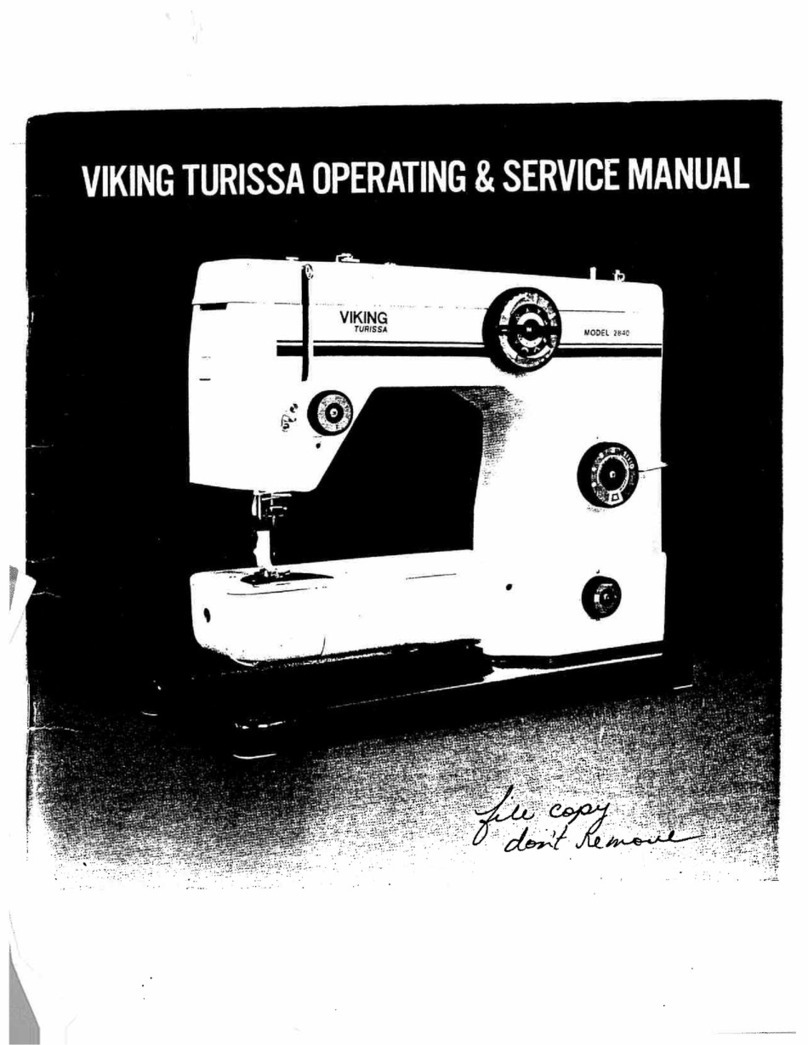
Viking
Viking Turissa Service manual

Viking
Viking Huskystar C10 User manual
